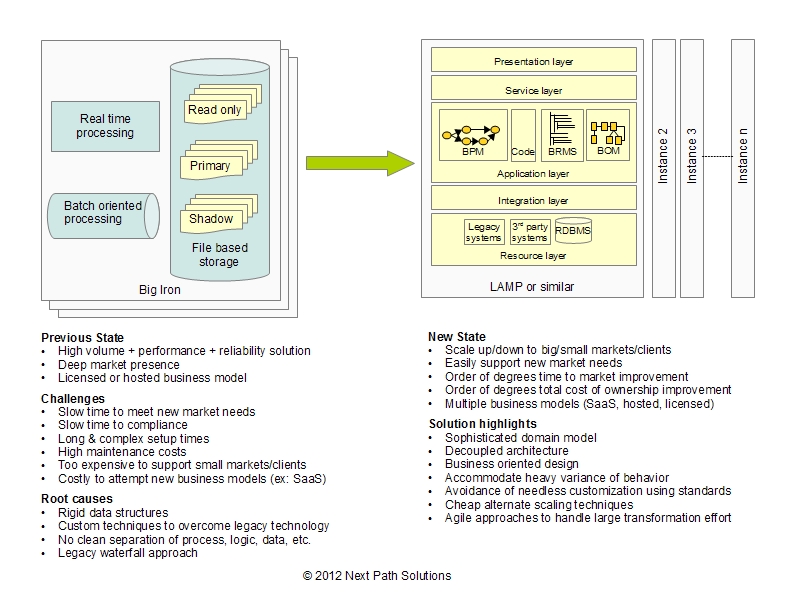Next Generation Payment Processing Platform
We were asked by our client to take on a core engineering problem, not to simply theorize on a way forward (beware the “reams of boilerplate documentation” some vendors provide), but to make it a reality.

The initial goal was to salvage the existing legacy system and build modernization layers around it. Our analysis however, showed that the root causes were at the very core, and that we had to take the opposite approach i.e. salvage some of the layers around it initially while rebuilding an alternate core. We employed the Next Path delivery model to manage a globally distributed effort with a team resourced by the client, product vendors, and other consulting vendors. With clearly articulated analysis, and a demonstrable architectural prototype, we earned the clients’ trust that we had a good handle on the specific architecture and design needed to fulfill the business vision.
To accommodate the ever changing market needs (new payment instruments, compliance changes, etc.), the variance of behavior desired by a processor’s clients, and the complex business functionality in this space, we first create a sophisticated yet extensible domain model. After validating this model against the architecturally significant user stories (via prototype testing, and thought experiments), we outlined an initial architecture specification. This included the prioritized list of all abstractions (cross cutting mechanisms, reusable functionality, integration plumbing) that would evolve as a framework on top of which the rest of the team could build business functionality.
From the very beginning, heavy emphasis was put on achieving KPI targets (ex: short time to client setup, short time to compliance, etc.), and systemic qualities (usability, security, flexibility, maintainability, portability, response time, throughput, scalability, high availability, etc.). Using a standards based technology stack, the solution was built to run on cheap hardware, and to scale horizontally. Performance testing and capacity planning was done from the get go which resulted in better tuning, design improvements, and clearer understanding of future deployment layouts. The solution was built to support both isolated-tenant and multi-tenant SaaS hosting models to address the needs of small and big markets, as well as regional security concerns. Several complex customizations in the legacy system were dispensed with. For example, finer grained optimistic locking standards and techniques easily addressed the need to simultaneously perform batch and real time. Proper decoupling and organization of business logic removed the need to have hard notions on which functions are batch vs. real time. Ability to “hot delploy” business rules allowed several changes to occur outside the slow SDLC paradigm.
To avoid being bogged down by this significant transformation effort, we employed Agile techniques. We started demonstrating progress in short increments from an early stage. We allowed for changing requirements given that the ask was to replace a complex multi-decade old system that no one fully understood. We started with a small team and grew into a large globally distributed team of teams, to achieve the business goals on a reasonable schedule. Using techniques such as “Scrum of Scrums”, hybrid team organization structure (vertical and horizontal as applicable), onshore coordinator for offshore team, etc., we were able to achieve scale while not drastically effecting individual team velocity. Program management expertise was put in place to coordinate this massive effort, keeping all parties in the loop and working together towards common goals. Upon initial roll out, this extensible solution and this delivery model were transitioned to the client, to continue future growth.



